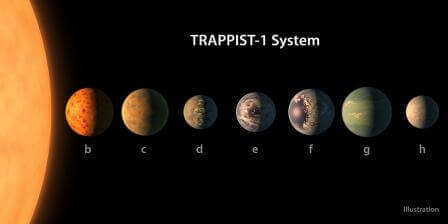6 Things You Should Know About the New Planet Discovery
Last week NASA made the historic announcement that seven Earth-sized planets had been found around a single star. What do you need to know about the new TRAPPIST-1 system?
Last week NASA made the historic announcement that seven Earth-sized planets had been found around a single star. Astronomers have found Earth-sized planets before, but never so many orbiting the same star, in this case an ultracool M-dwarf known as TRAPPIST-1.
Amidst the flurry of press coverage this announcement has inspired, here are six important points summarizing both why the star TRAPPIST-1 and its seven planets are so important, as well as how this discovery raises even more questions about life on other planets.
1. Three of the planets are crammed into the star’s habitable zone.
Some stars burn brighter (and hotter) than others, and so the range in distances from a star that result in temperatures amenable to liquid water will vary from star to star. Since water is a key ingredient for life like us, this range of radii where temperatures are not too cold and not too hot but instead “just right” are sometimes called the “Goldilocks region” or the star’s habitable zone.
Of the seven Earth-sized planets found around TRAPPIST-1, three reside in the habitable zone. However, distance from its host star isn’t the only determining factor in a planet’s temperature: atmosphere also plays a big role. For example, here in our solar system, Venus, Earth, and Mars are all in our sun’s habitable zone. Unfortunately for our potential future travel plans, Venus is experiencing a runaway greenhouse effect that creates a very thick atmosphere which is very good at trapping in heat like an extremely warm blanket. On the other hand, the atmosphere on Mars is quite thin, leading to large temperature changes from day to night. Thus, give or take a little atmosphere, any one of the seven TRAPPIST-1 planets could host temperatures hospitable to life, but the ones in the habitable zone have a better chance.
2. TRAPPIST-1 is not a star like our sun.
Our sun is an average G-type star, which means it emits the most light at white to yellow wavelengths and has a surface temperature of 5,000-6,000 Kelvin, which is somewhere in the middle of the range of temperatures stars are known to exhibit. TRAPPIST-1 is an ultracool M-dwarf which means it is on the order of 10 times smaller than our Sun – in fact, it’s barely bigger than Jupiter – and has a surface temperature less than half that of the Sun’s.
This cooler temperature means that the habitable zone for TRAPPIST-1 is much closer to the star than is the case in our own solar system. The three planets found in habitable zone for TRAPPIST-1 have orbital periods between 6 to 12 days, meaning that “a year” on one of these newly discovered planets spans less than what we would call 2 weeks here on Earth. In fact, the whole system is barely larger than Mercury’s orbit around the Sun. Such close quarters make it even more impressive that 3 planets are found crammed into the habitable zone.
Another important distinction between stars like the Sun and stars like TRAPPIST-1, is their activity. According to Dr. Bárbara Rojas Ayala, an expert on M-dwarfs and an assistant professor in Santiago, Chile, ultracool M-dwarfs can be very active. “Their flares can be quite powerful and thus the high energy radiation they produce in the form of X-rays and ultraviolet radiation can affect the atmospheres – and thus the habitability – of their planets.”
3. The transit method of exoplanet discovery can only tell us so much.
The name TRAPPIST-1 comes from the name of the telescope to first identify the system last year as a potential multi-planet system, the Transiting Planets and Planetesimals Small Telescope in Chile. Later, the European Southern Observatory’s Very Large Telescope, and the Spitzer Space Telescope not only worked to confirm the original discovery but also found additional companions for a total of seven.
Astronomers have not observed these planets directly but instead discovered them using the transit method. As the planets pass in front of their star, they cause a slight dimming in the light astronomers observe from that star. How much the light dims and how long the light is dimmed for can tell us about the size, mass, and thus density of the planet causing the dip. However, the transit method still leaves a lot of room for interpretation, especially as far as the habitability of a planet is concerned, suggesting that these planets will be highly sought after targets for followup observations like those that will be possible with upcoming powerful telescopes like the James Webb Space Telescope (or JWST).
Dr. Rojas Ayala cautions that we still do not know enough about the planets to tell if they are indeed like Earth or if they could be more like Venus. “Just looking at the bulk properties of Earth and Venus, they look like twins, but obviously they have very different geological histories. These new planets will be exciting targets for JWST which can tell us what their atmospheres are like.”
4. The planets might be tidally locked with TRAPPIST-1.
The close proximity of all seven planets to their star and to each other suggest that they may be tidally locked with one side of the planet always facing TRAPPIST-1 while the other always faces away. Thus, if you’re a fan of both night and day, a visit to one of the TRAPPIST-1 planets may not be for you. Those who have heard of the dark side of the Moon may recall that the Moon is also tidally locked with the Earth, even though the so-called dark side isn’t really all that dark.
5. TRAPPIST-1 is far from being a reliable back up plan.
The TRAPPIST-1 system is “only” 39 light years away which is about 10 times farther than our closest neighbor Alpha Centauri. While 39 lightyears is relatively close astronomically speaking, it is still nearly 230 trillion miles away. Interstellar travel is incredibly challenging – we have not yet sent probes beyond our own solar system and humans themselves have never been farther than the Moon.
TRAPPIST-1 is also a relatively young star at an age of ~500 million years old, compared to the Sun’s 4.5 billion years. Although such a young age doesn’t rule out the possibility of terraforming, TRAPPIST-1 may not have been in existence long enough for life as we know it to have evolved.
It is still of the utmost importance to take care of our own planet rather than depend on mass emigration to other planets in the future.
Thus, it is still of the utmost importance to take care of our own planet rather than depend on mass emigration to other planets in the future.
6. The TRAPPIST-1 discovery has important implications for the success of future planet searches.
The first exoplanet discovery was confirmed in 1991 and now, less than 30 years later, we know of more than 3400 confirmed planets around other stars. Of course, all Pluto drama aside, we know our Sun hosts multiple planets. And now that we know that seven planets, especially seven planets either in or near their star’s habitable zone, can exist around a single star, the chances of finding a spot hospitable for life have effectively been multiplied by seven.
More importantly, perhaps, is the fact that M-dwarfs are believed to vastly outnumber stars like our sun. Thus, the more examples we can find of habitable or even potentially habitable planets around M-dwarfs, the better the odds become that habitable planets also exist in the regions of the Galaxy we have not yet explored.
Until next time, this is Sabrina Stierwalt with Ask Science’s Quick and Dirty Tips for helping you make sense of science. You can become a fan of Ask Science on Facebook or follow me on Twitter, where I’m @QDTeinstein. If you have a question that you’d like to see on a future episode, send me an email at everydayeinstein@quickanddirtytips.comcreate new email.
Image courtesy of nasa.gov







